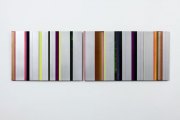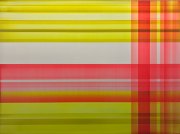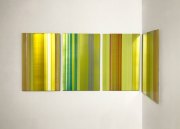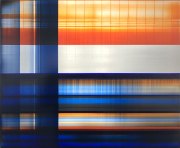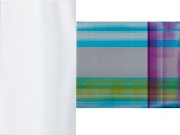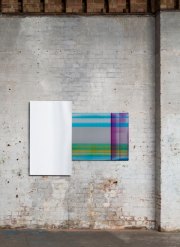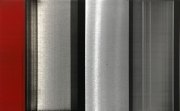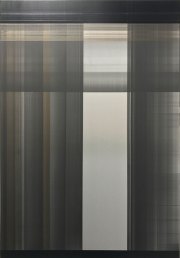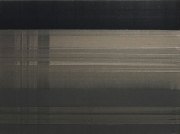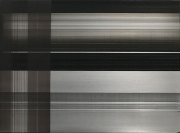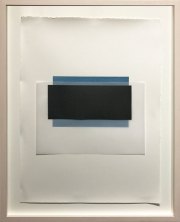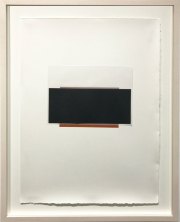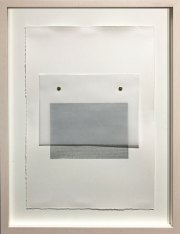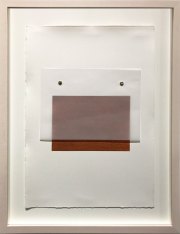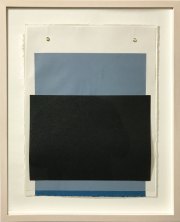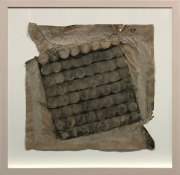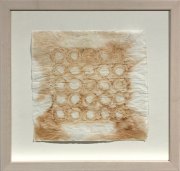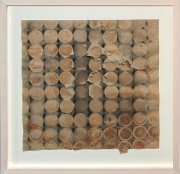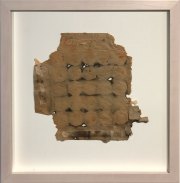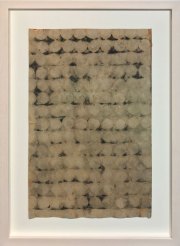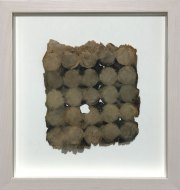
Eric Butcher, P/R 690, 2017, Oil and Resin on Aluminum, 15.8 x 50 Inches (Two Parts)
ARTIST RECEPTION
Saturday, April 7 , 2018, 5pm to 7pm
Facebook Event Page
EXHIBITION DATES
April 6 to May 19, 2018
Nancy Toomey Fine Art is pleased to announce Artificial Light, an exhibition of works by UK artist Eric Butcher, on view from April 6 to May 19, 2018. The gallery is located inside San Francisco’s Minnesota Street Project, 1275 Minnesota Street. The public is invited to the artist reception on Saturday, April 7, from 5pm to 7pm. Join the event page here.
For the past two decades Butcher has developed a creative practice both reductive and rule governed. It has evolved slowly, deliberately, and incrementally. Working primarily with oil paint or graphite suspended in resin, a transparent monochrome is spread across the surface of his aluminum support and then stripped off, using a variety of metal blades drawn across the surface. This procedure is then repeated, slowly building up an accumulation of thin residues.

Eric Butcher, P/R 728, 2017, Oil and Resin on Aluminum, 31.5 x 42.5 / 49.2 x 27.5 Inches
This methodology evidences an increasingly deterministic approach to the creative act. A set of procedures have been developed which involve taking away and systematizing significant elements of decision making rather than relying on the contingent, intuitive or whimsical. The painterly process has been distilled to a set of rituals, patterns of behavior, endlessly repeated, a mechanistic performance carried out in private, made public.
The outcome is in part determined by imperfections in the metal surface, either through the process of its manufacture (e.g. the minute corrugations caused by extrusion), or the results of handling, cutting, the burr of its edge, accidental knocks and dents sustained in the warehouse and so on. Each tiny imperfection is amplified by the process of stripping, leaving a ridge of denser color to register its often otherwise imperceptible presence.

Eric Butcher, P/R 800, 2017, Oil and Resin on Aluminum, 31.4 x 42.5 Inches
Over years of use, the stripping blades develop subtle accretions of paint along their edges. The gradual accumulation of thin residues create tiny variations of unevenness on the edge of the blade which effect the density of paint as it is stripped away. Consequently each finished surface holds within itself the traces and evidence of the manufacture of previous surfaces. It contains within it the memory of every act of stripping away, subtraction, and destruction.

Eric Butcher, P/R 814, 2018, Graphite, Bronze, Oil and Acrylic Gel on Aluminum, 31.5 x 21.7 Inches
Paradoxically, in adopting this quasi-mechanized approach–free of emotion, free of explicit content–a quintessentially human quality emerges. When compared with the perfection of machine production, the limitations and failures of the human hand are writ large. Everything in the painted surface that deviates from a flat, featureless monochrome is predicated upon error or impurity, human or material. As such this artistic practice represents a glorification of error and a celebration of what makes us human.

Eric Butcher, F/R 767 (Memento), 2017, Clay and Gunpowder Residue on Burnt Paper, 7.1 x 7.1 Inches
The gunpowder pieces are a recent development (part of an ongoing series, one of which was recently shortlisted for the prestigious UK-based Jerwood Drawing Prize), which Butcher describes as “found drawings.” Carefully extracted from the base of spent fireworks launchers, they have been created by the presence, now absent, of rows of firework cartridges. The area around the base of each cartridge is burnt and blackened or in some cases burnt away entirely as the firework launches, while the area beneath the circular base of the cartridge is preserved by the presence of a clay plug, an integral part of the construction of the cartridge.
They are the remnants of events now past, consigned to the mutability of memory. These pieces of burnt paper are all that are left. Each is a trace of the physical processes which formed it, determined entirely by characteristics of the materials and processes involved. In this respect these works are entirely consistent with the deterministic concerns of his paintings and represent an extension of those preoccupations through a different methodology. But they are also a catalyst for memory.

Eric Butcher
Born in Singapore in 1970, Eric Butcher moved to England in 1974. He studied philosophy at Cambridge University and fine art at Wimbledon School of Art, London. He has exhibited extensively in the UK and internationally with shows in Austria, Germany, Italy, Switzerland and the USA. His creative practice also embraces curating; initiating exhibitions including Definite Article (2005/6), Underground (2007), The Devil Finds Work for Idle Hands (2012) and A Machine Aesthetic (2013/14). He currently lives and works in Oxfordshire, England and shows with Galerie Robert Drees, Hannover, Patrick Heide Gallery, London and Nancy Toomey Fine Art, San Francisco.
